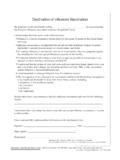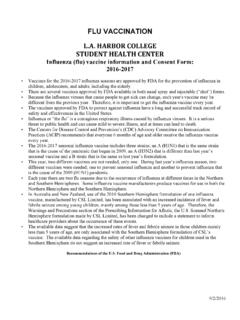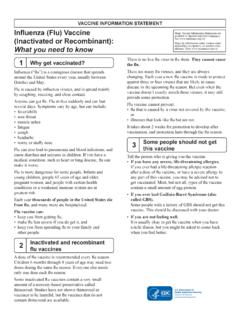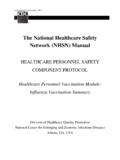Transcription of Seasonal Influenza Vaccine Production Process
1 ATo ensure safety and purity, Vaccine is produced in a clean environment where quality control experts enforce strict standards, continuously monitoring the Process ; bThemajority of time for Bulk Manufacturing and Production and Purification and Testing is dedicated to testing and approval.; cThis Process makes it impossible to contract Influenza from the Vaccine upon adminis-tration; dCenters for Disease Control and Prevention; eChildren younger than 9 years of age receiving vaccination for the first time need 2 doses 1 month apart. Surveillance The Seasonal Influenza Vaccine protects against the 3 most prominent virus strains circulating in a given year, which must first be identified before Production can begin each year. Ongoing global surveillance is key toStrainSelectionJanuary-MarchOctober and BeyondAugust-November;Beyond as neededJuly-DecemberJune-OctoberJanuary-J uly Based on the surveillance, WHO makes a strain recommendation in February for the Northern Hemisphere and in September for the Southern Hemisphere.
2 In the , the strains are submitted to the Food and Drug Administration (FDA) torecommend which 3 to include. WHO coordinates seed virus Productiona,b Millions of specially-prepared chicken eggs are used to produce the Vaccine . Throughout the year, fertilized eggs are delivered to the manufacturer. Each egg is injected with 1 strain. Each virus strain is produced separately, and later combined to make 1 Vaccine . The eggs are incubated for several days to allow the virus to multiply. After incubation, the virus-loaded fluid is and Testinga,b The virus fluid undergoes multiplepurification steps and a special chemicaltreatment to ensure the virus is inactivated,or killed. c The virus is split by chemically disrupting thewhole virus. Manufacturers test the Vaccine concentrateto determine amount and yield of the virus toensure concentrate is adequate ,Filling andPackaging Viral fragments from all 3 strains arecollected from different batches, andcombined upon completion of quality control tests.
3 Quality control tests are performed on all 3 strains for purity, sterility and potency in each step of the Production Process . Manufacturers begin filling the doses into vials and syringes, which are then sealed and carefully inspected before labels are applied to show the Vaccine batch, lot numbers, and expiration date. Each lot must be specifically released by the FDA before manufacturers can ship Vaccine shipments typically begin in August or September and continue into November. With the CDC sd support, partial shipments are sent early in the season to all customers to ensure broad access for high-risk patients. Depending on viral yields and virus activity,additional doses may be released anddistributed into December and beyond tosupport late-season The CDC recommends an annualinfluenza immunization for anyone who wishes to reduce their risk of contracting Influenza : children 6 months through 18 years of age; adults 50 years of age and older; pregnant women; and anyone with chronic health conditions such as asthma, chronic obstructive pulmonary disease (COPD), heart disease, and diabetes.
4 Immunization may begin as soon as Vaccine becomes available and continues through the Influenza season, which typically ends in March. Immunity develops approximately 2 weeksfollowing Influenza Vaccine Production ProcessYear Round312213predicting which 3 strains will circulate each Influenza season. Scientists around the world submit samples to the World Health Organization and its reference laboratories, such as the Centers for Disease Control, which anaylze and identify thecirculating here to see sanofi pasteur s BulkInfluenza Vaccine Manufacturing ProcessCourtesy of sanofi pasteur, May 2009







